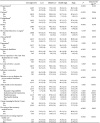| Korean J Health Promot > Volume 17(1); 2017 > Article |
|
ABSTRACT
Background
Methods
Results
REFERENCES
Table 1
General characteristics and health behaviors according to house hold income groups aged over 35 years women.

Values are presented as unweighted number.
Continuous variables: estimated mean±SE, Categorical variables: % (SE).
P values are obtained by cross tabulation analysis (Rao-Scott chi-square test) in complex sample design.
aP values are obtained by general linear regression model in complex sample design.
bHigh risk drinking for women is defined as more than twice a week.
cExercise is defined as high intensity exercise 20 minutes more than 3 times per week or moderate intensity exercise 30 minutes more than 5 times per week or walking 30 minutes more than 5 times per week.
Table 2
Morbidity, health status, health care utilization according to house hold income groups aged over 35 years women.

Table 3
Anthropometric measurement and biochemical factors according to house hold income groups aged over 35 years women.

Abbreviations: BMI, body mass index; SBP, systolic blood pressure; DBP, diastolic blood pressure; GOT, glutamic oxalacetic transaminase; GTP, glutamic pyruvate transaminase; BUN, blood urea nitrogen; LDL-chol, low density lipoprotein cholesterol; HDL-chol, high density lipoprotein cholesterol; FBS, fasting blood sugar.
Values are presented as unweighted number (estimated mean±SE).
P values are obtained by general linear regression model in complex sample design.
aAssessed by logistic regression analysis.
Table 4
Number of cardiovascular disease risk according to house hold income groups aged over 35 years women.

Abbreviation: HTN, hypertension; BMI, body mass index; HDL-chol, high density lipoprotein cholesterol.
Values are presented as unweighted number.
Continuous variables: estimated mean±SE, Categorical variables: % (SE).
P values are obtained by cross tabulation analysis (Rao-Scott chi-square test) in complex sample design.
aAssessed by logistic regression analysis
bP values are obtained by general linear regression model in complex sample design.
cLack of exercise is defined as not doing high intensity exercise 20 minutes more than 3 times per week or moderate intensity exercise 30 minutes more than 5 times per week or walking 30 minutes more than 5 times per week.
-
METRICS

-
- 7 Crossref
- 0 Scopus
- 827 View
- 1 Download
- Related articles




 PDF Links
PDF Links PubReader
PubReader ePub Link
ePub Link Full text via DOI
Full text via DOI Download Citation
Download Citation Print
Print


